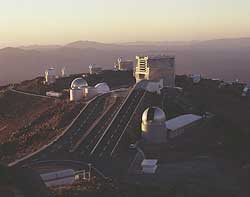La Silla Observatory

An observatory atop the 2,400-meter La Silla mountain that borders the southern extremity of the Atacama desert in Chile, about 160 km north of La Serena at 29° 15' S, 70° 44' W. Operated by the European Southern Observatory (ESO), its instruments include a 3.6-meter reflector opened in 1976, the 3.5-m New Technology telescope, opened in 1989, a 1.52-meter reflector, opened in 1968, a 1-meter Schmidt, opened in 1972, and 1-meter photometric telescope, opened in 1968. Also at La Silla is the 15-meter Swedish-ESO Submillimetre Telescope, the Leonhard Euler Telescope, and a variety of other instruments owned by individual nations.
Leonhard Euler Telescope
The Leonhard Euler Telescope is a 1.2-meter Swiss reflector, built at the Geneva Observatory, located at La Silla Observatory, operated by the University of Geneva, and named in honor of the famous Swiss mathematician. It is used specifically, in conjunction with the Coralie spectrograph, to conduct high-precision radial velocity measurements principally to search for large exoplanets in the southern celestial hemisphere. Its first success was the discovery of a planet in orbit around Gliese 86.


